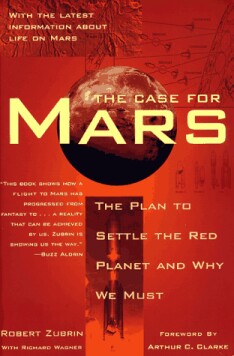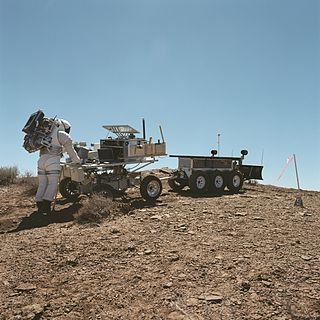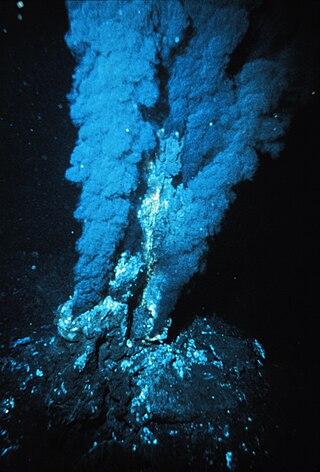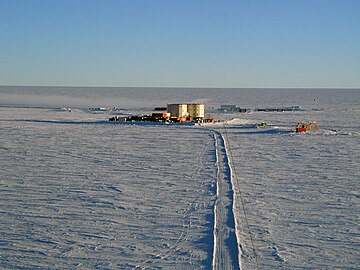The Mars Society is a nonprofit organization that advocates for human exploration and colonization of Mars. It was founded by Robert Zubrin in 1998 and its principles are based on Zubrin's Mars Direct philosophy, which aims to make human missions to Mars as feasible as possible. The Mars Society generates interest in the Mars program by garnering support from the public and through lobbying. Many current and former Mars Society members are influential in the wider spaceflight community, such as Buzz Aldrin and Elon Musk.

The Case for Mars: The Plan to Settle the Red Planet and Why We Must is a nonfiction science book by Robert Zubrin, first published in 1996, and revised and updated in 2011.

Artificial gravity is the creation of an inertial force that mimics the effects of a gravitational force, usually by rotation. Artificial gravity, or rotational gravity, is thus the appearance of a centrifugal force in a rotating frame of reference, as opposed to the force experienced in linear acceleration, which by the equivalence principle is indistinguishable from gravity. In a more general sense, "artificial gravity" may also refer to the effect of linear acceleration, e.g. by means of a rocket engine.

The effects of spaceflight on the human body are complex and largely harmful over both short and long term. Significant adverse effects of long-term weightlessness include muscle atrophy and deterioration of the skeleton. Other significant effects include a slowing of cardiovascular system functions, decreased production of red blood cells, balance disorders, eyesight disorders and changes in the immune system. Additional symptoms include fluid redistribution, loss of body mass, nasal congestion, sleep disturbance, and excess flatulence. A 2024 assessment noted that "well-known problems include bone loss, heightened cancer risk, vision impairment, weakened immune systems, and mental health issues... [y]et what’s going on at a molecular level hasn’t always been clear", arousing concerns especially vis a vis private and commercial spaceflight now occurring without any scientific or medical research being conducted among those populations regarding effects.

The colonization of Mars is the proposed process of establishing and maintaining control of Martian land for exploitation and the possible settlement of Mars. Most colonization concepts focus on settling, but colonization is a broader ethical concept, which international space law has limited, and national space programs have avoided, instead focusing on human mission to Mars for exploring the planet. The settlement of Mars would require the migration of humans to the planet, the establishment of a permanent human presence, and the exploitation of local resources.

Pascal Lee is a Hong-Kong-born scientist who is the co-founder and chairman of the Mars Institute, a planetary scientist at the SETI Institute, and the Principal Investigator of the Haughton–Mars Project (HMP) at NASA Ames Research Center in Mountain View, California. He holds an ME in geology and geophysics from the University of Paris, and a PhD in astronomy and space sciences from Cornell University.

NASA's Desert Research and Technology Studies is a group of teams which perform an annual series of field trials seeking to demonstrate and test candidate technologies and systems for human exploration of the surface of the Moon, Mars, or other rocky bodies.

The idea of sending humans to Mars has been the subject of aerospace engineering and scientific studies since the late 1940s as part of the broader exploration of Mars. Long-term proposals have included sending settlers and terraforming the planet. Currently, only robotic landers and rovers have been on Mars. The farthest humans have been beyond Earth is the Moon, under the U.S. National Aeronautics and Space Administration (NASA) Apollo program which ended in 1972.

Space architecture is the theory and practice of designing and building inhabited environments in outer space. This mission statement for space architecture was developed in 2002 by participants in the 1st Space Architecture Symposium, organized at the World Space Congress in Houston, by the Aerospace Architecture Subcommittee, Design Engineering Technical Committee (DETC), American Institute of Aeronautics and Astronautics (AIAA).

Astrobiology Science and Technology for Exploring Planets (ASTEP) was a program established by NASA to sponsor research projects that advance the technology and techniques used in planetary exploration. The objective was to enable the study of astrobiology and to aid the planning of extraterrestrial exploration missions while prioritizing science, technology, and field campaigns.
Human analog missions are activities undertaken on Earth in various environments to simulate aspects of human missions to other worlds, including the Moon, asteroids, and Mars. These remote field tests are performed in locations that are identified based on their physical similarities to the extreme space environments of a target mission. Such activities are undertaken to test hardware and operational concepts in relevant environments.
Terrestrial analogue sites are places on Earth with assumed past or present geological, environmental or biological conditions of a celestial body such as the Moon or Mars. Analogue sites are used in the frame of space exploration to either study geological or biological processes observed on other planets, or to prepare astronauts for surface extra-vehicular activity.

Space farming refers to the cultivation of crops for food and other materials in space or on off-Earth celestial objects – equivalent to agriculture on Moon.

The Hawaii Space Exploration Analog and Simulation (HI-SEAS) is an analog habitat for human spaceflight to Mars currently operated by the International MoonBase Alliance. HI-SEAS is located in an isolated position on the slopes of the Mauna Loa volcano on the island of Hawaii. The area has Mars-like features and an elevation of approximately 8,200 feet (2,500 m) above sea level. The first HI-SEAS study was in 2013 and NASA's Human Research Program continues to fund and sponsor follow-up studies. The missions are of extended duration from four months to a year. Its missions place HI-SEAS in the company of a small group of analogs that are capable of operating very long duration missions in isolated and confined environments, such as Mars500, Concordia, and the International Space Station.
A Mars analog habitat is one of several historical, existing or proposed research stations designed to simulate the physical and psychological environment of a Martian exploration mission. These habitats are used to study the equipment and techniques that will be used to analyze the surface of Mars during a future crewed mission, and the simulated isolation of the volunteer inhabitants allows scientists to study the medical and psychosocial effects of long-term space missions. They are often constructed in support of extensive Mars analogs. However, sometimes existing natural places are also valued as Mars analogs. Crewed Mars habitats are featured in most human Mars missions; an alternative may be terraforming or telepresence.

A Mars habitat is a hypothetical place where humans could live on Mars. Mars habitats would have to contend with surface conditions that include almost no oxygen in the air, extreme cold, low pressure, and high radiation. Alternatively, the habitat might be placed underground, which helps solve some problems but creates new difficulties.

Martian Moons eXploration (MMX) is a robotic space probe set for launch in 2026 to bring back the first samples from Mars' largest moon Phobos. Developed by the Japan Aerospace Exploration Agency (JAXA) and announced on 9 June 2015, MMX will land and collect samples from Phobos once or twice, along with conducting Deimos flyby observations and monitoring Mars's climate.

A Mars suit or Mars space suit is a space suit for EVAs on the planet Mars. Compared to a suit designed for space-walking in the near vacuum of low Earth orbit, Mars suits have a greater focus on actual walking and a need for abrasion resistance. Mars' surface gravity is 37.8% of Earth's, approximately 2.3 times that of the Moon, so weight is a significant concern, but there are fewer thermal demands compared to open space. At the surface the suits would contend with the atmosphere of Mars, which has a pressure of about 0.6 to 1 kilopascal. On the surface, radiation exposure is a concern, especially solar flare events, which can dramatically increase the amount of radiation over a short time.

The Swamp Works is a lean-development, rapid innovation environment at NASA's Kennedy Space Center. It was founded in 2012, when four laboratories in the Surface Systems Office were merged into an enlarged facility with a modified philosophy for rapid technology development. Those laboratories are the Granular Mechanics and Regolith Operations Lab, the Electrostatics and Surface Physics Lab, the Applied Chemistry Lab, and the Life Support and Habitation Systems (LSHS) team. The first two of these are located inside the main Swamp Works building, while the other two use the facility although their primary work is located elsewhere. The team developed the Swamp Works operating philosophy from Kelly Johnson's Skunk Works, including the "14 Rules of Management", from the NASA development shops of Wernher von Braun, and from the innovation culture of Silicon Valley. The team prototypes space technologies rapidly to learn early in the process how to write better requirements, enabling them to build better products, rapidly, and at reduced cost. It was named the Swamp Works for similarity with the Skunk Works and the Phantom Works, but branded by the widespread marshes (swamps) on the Cape Canaveral and Merritt Island property of the Kennedy Space Center. The Swamp Works was co-founded by NASA engineers and scientists Jack Fox, Rob Mueller, and Philip Metzger. The logo, a robotic alligator, was designed by Rosie Mueller, a professional designer and the spouse of Rob Mueller.

Ladakh Human Analogue Mission (LHAM) is a human analog mission by ISRO's Human Space Flight Centre, AAKA Space Studio, University of Ladakh and IIT Bombay in collaboration with the Ladakh Autonomous Hill Development Council, Leh. The mission began on 1 November 2024. Mission aims to make suitable interplanetary conditions for astronaut training. This is India's first human analogue mission.




















